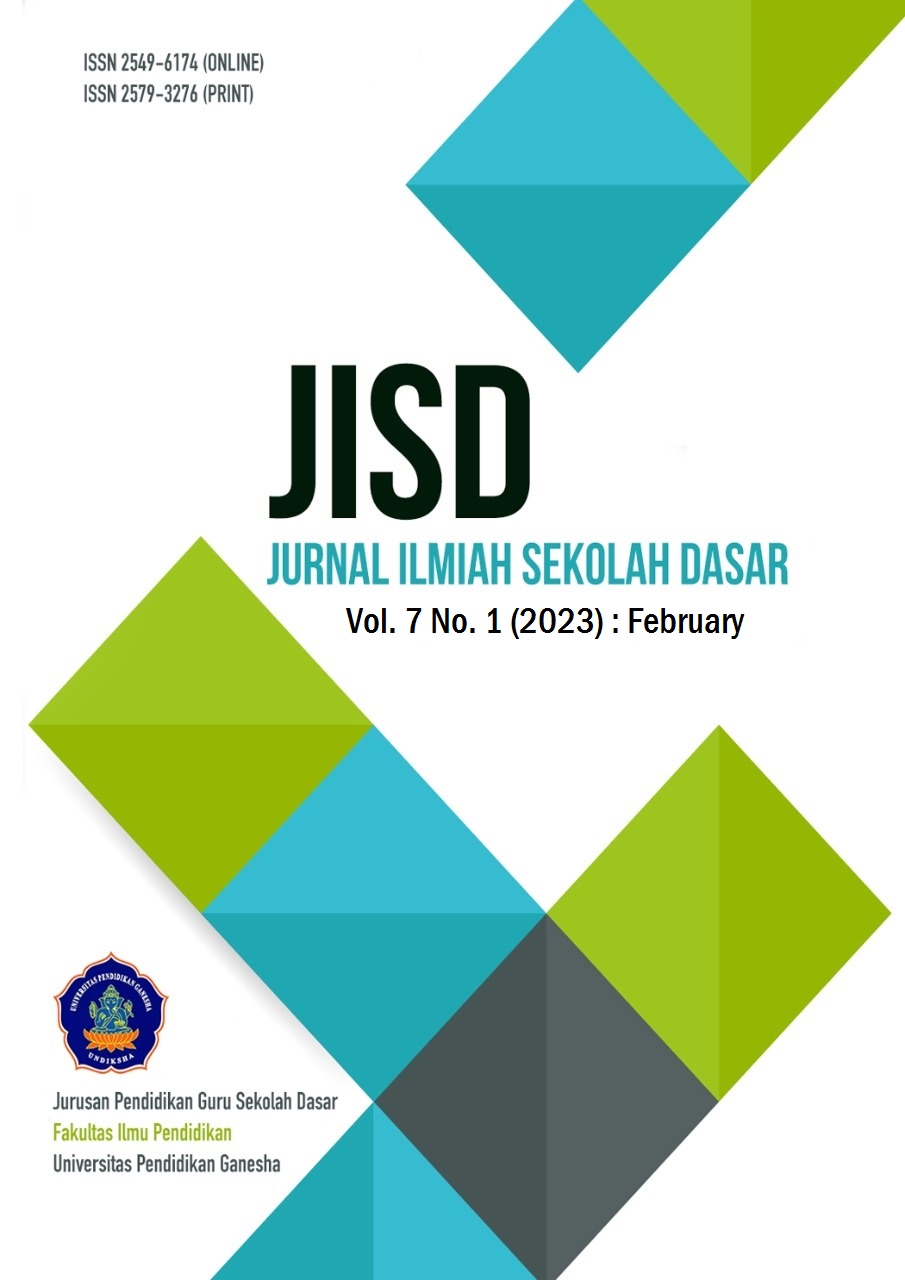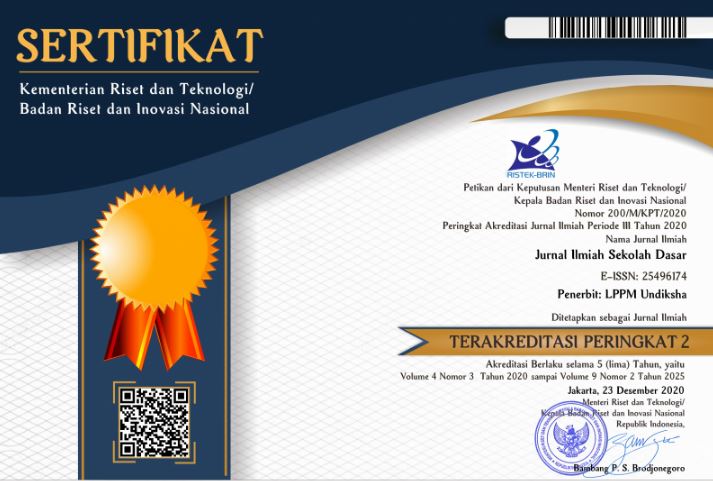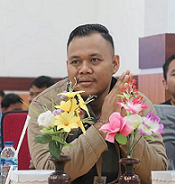Implementation of The Education Curriculum For ABK
DOI:
https://doi.org/10.23887/jisd.v7i1.54968Keywords:
Inclusive education, curriculum, students with special needsAbstract
Regulations on inclusive education explain in more detail about inclusive education as an education delivery system that provides opportunities for all students who have disabilities and have potential intelligence and/or special talents to participate in education and learning in an educational environment together with other students. This study aims to analyses the implementation of educational curriculum for students with special needs. Researchers used a qualitative approach with the case study method which was carried out by observation, research, implementation, data analysis and preparation of research reports. This study involves a principal, 2 teachers and 2 guardians of students with special needs. This study uses data collection techniques including observation, interviews and documentation studies. Data analysis in this study was carried out through stages including data collection, data reduction, data classification, and making conclusions. The results showed that the school is still not optimal in implementing the curriculum for students with special needs at school due to a lack of understanding and the high difficulty of controlling the learning process, especially in the delivering material and assessment section.
References
Abunab, H. Y., Dator, W. L. T., Salvador, J. T., & Lacanaria, M. G. C. (2017). Solitude, Religious and Cultural Uniqueness in a Foreign Environment: Adjustments as an Arab Student. Journal of Religion and Health, 56(5), 1701–1718. https://doi.org/10.1007/s10943-017-0425-x. DOI: https://doi.org/10.1007/s10943-017-0425-x
Ahmad, R. (2010). Memaknai Dan Mengembangkan Keberagaman Peserta Didik Melalui Pendidikan Inklusif. Pedagogi: Jurnal Ilmu Pendidikan, 10(2), 70. https://doi.org/10.24036/pedagogi.v10i2.2243. DOI: https://doi.org/10.24036/pedagogi.v10i2.2243
Anastasiou, D., Kauffman, J. M., & Di Nuovo, S. (2015). Inclusive education in Italy: description and reflections on full inclusion. European Journal of Special Needs Education, 30(4), 429–443. https://doi.org/10.1080/08856257.2015.1060075. DOI: https://doi.org/10.1080/08856257.2015.1060075
Arnold, S., & Reed, P. (2019). Measuring the word recognition abilities of children who are both verbal and nonverbal with ASD using a traditional paper-based and a novel digital test format. British Journal of Special Education. https://doi.org/10.1111/1467-8578.12279. DOI: https://doi.org/10.1111/1467-8578.12279
Bakhshi, P., Babulal, G. M., & Trani, J. F. (2017). Education of children with disabilities in New Delhi: When does exclusion occur? PLoS ONE, 12(9), 1–15. https://doi.org/10.1371/journal.pone.0183885. DOI: https://doi.org/10.1371/journal.pone.0183885
Budiarti, N. D., & Sugito, S. (2018). Implementation of Inclusive Education of Elementary Schools: a Case Study in Karangmojo Sub-District, Gunungkidul Regency. Journal of Education and Learning (EduLearn), 12(2), 214–223. https://doi.org/10.11591/edulearn.v12i2.8727. DOI: https://doi.org/10.11591/edulearn.v12i2.8727
Cioè-Peña, M. (2017). The intersectional gap: how bilingual students in the United States are excluded from inclusion. International Journal of Inclusive Education, 21(9), 906–919. https://doi.org/10.1080/13603116.2017.1296032. DOI: https://doi.org/10.1080/13603116.2017.1296032
Cohen, L., Manion, L., & Morrison, K. (2018). Research methods in education (8thed ed.). Routledge. DOI: https://doi.org/10.4324/9781315456539
Deppeler, J., Loreman, T., & Smith, R. (2015). Teaching and learning for all. International Perspectives on Inclusive Education, 7, 1–10. https://doi.org/10.1108/S1479-363620150000007010. DOI: https://doi.org/10.1108/S1479-363620150000007010
Done, E. J., & Andrews, M. J. (2019). How inclusion became exclusion : policy , teachers and inclusive education. Journal of Education Policy, 00(00), 1–18. https://doi.org/10.1080/02680939.2018.1552763. DOI: https://doi.org/10.1080/02680939.2018.1552763
Garzia, M., Yufiarti, Y., & Hartati, S. (2019). Perbedaan Kesiapan Sekolah Anak Usia Dini di Daerah Pesisir Ditinjau dari Status Ekonomi Orang Tua dan Parenting. Jurnal Obsesi : Jurnal Pendidikan Anak Usia Dini, 3(2), 470. https://doi.org/10.31004/obsesi.v3i2.239. DOI: https://doi.org/10.31004/obsesi.v3i2.239
Goodall, C. (2018). ‘I felt closed in and like I couldn’t breathe’: A qualitative study exploring the mainstream educational experiences of autistic young people. Autism and Developmental Language Impairments, 3. https://doi.org/10.1177/2396941518804407. DOI: https://doi.org/10.1177/2396941518804407
Hamidaturrohmah, & Mulyani, T. (2020). Strategi Pembelajaran Jarak Jauh Siswa Berkebutuhan Khusus Di Sd Inklusi Era Pandemi Covid-19. ELEMENTARY: Islamic Teacher Journal, 8(2), 247. https://doi.org/10.21043/elementary.v8i2.7907. DOI: https://doi.org/10.21043/elementary.v8i2.7907
Hartanto, D., & Yuliani, S. (2019). Pola Pengasuhan Anak Dalam Konteks Pendidikan Peran Pemerintah Dan Orang Tua. Perspektif Pendidikan Dan Keguruan, 10(1), 90–98. https://doi.org/10.25299/perspektif.2019.vol10(1).3106. DOI: https://doi.org/10.25299/perspektif.2019.vol10(1).3106
Holifurrahman, H. (2020). Kurikulum Modifikasi dalam Praktik Pendidikan Inklusif di SD Al-Firdaus. Inklusi, 7(2), 271. https://doi.org/10.14421/ijds.070205. DOI: https://doi.org/10.14421/ijds.070205
Iacono, T., Keeffe, M., Kenny, A., & McKinstry, C. (2019). A Document Review of Exclusionary Practices in the Context of Australian School Education Policy. Journal of Policy and Practice in Intellectual Disabilities, 16(4), 264–272. https://doi.org/10.1111/jppi.12290. DOI: https://doi.org/10.1111/jppi.12290
Jurkowski, S., & Müller, B. (2018). Co-teaching in inclusive classes : The development of multi- professional cooperation in teaching dyads. Teaching and Teacher Education, 75, 224–231. https://doi.org/10.1016/j.tate.2018.06.017. DOI: https://doi.org/10.1016/j.tate.2018.06.017
Kamenopoulou, L., & Dukpa, D. (2018). Karma and human rights: Bhutanese teachers’ perspectives on inclusion and disability. International Journal of Inclusive Education, 22(3), 323–338. https://doi.org/10.1080/13603116.2017.1365274. DOI: https://doi.org/10.1080/13603116.2017.1365274
Kennedy et al. (2012). Literacy in Early Childhood and Primary Education. In Literacy in Early Childhood and Primary Education (Issue 15). National Council for Curriculum and Assessment. https://doi.org/10.1017/cbo9781139519397. DOI: https://doi.org/10.1017/CBO9781139519397
Lübke, L., Pinquart, M., & Schwinger, M. (2019). How to measure teachers’ attitudes towards inclusion: evaluation and validation of the Differentiated Attitudes Towards Inclusion Scale (DATIS). European Journal of Special Needs Education, 34(3), 297–311. https://doi.org/10.1080/08856257.2018.1479953. DOI: https://doi.org/10.1080/08856257.2018.1479953
Marlina. (2015). Asesmen Anak Berkebutuhan Khusus (Pendekatan Psikoedukasional). UNP Press.
Maya Damayanti, S., & Wicaksana, P. (2021). Financial Literacy and Risk Profile: an Extensive Observation on Bank Employees. Jurnal Aplikasi Manajemen, 19(1), 175–186. https://doi.org/10.21776/ub.jam.2021.019.01.16. DOI: https://doi.org/10.21776/ub.jam.2021.019.01.16
Óskarsdóttir, E., Donnelly, V., Turner-Cmuchal, M., & Florian, L. (2020). Inclusive school leaders – their role in raising the achievement of all learners. Journal of Educational Administration, 58(5), 521–537. https://doi.org/10.1108/JEA-10-2019-0190. DOI: https://doi.org/10.1108/JEA-10-2019-0190
Pappas, M. A., Papoutsi, C., & Drigas, A. S. (2018). Policies, practices, and attitudes toward inclusive education: The case of Greece. Social Sciences, 7(6). https://doi.org/10.3390/SOCSCI7060090. DOI: https://doi.org/10.3390/socsci7060090
Pinar, W. F. (2011). What Is Curriculum Theory? Routledge. https://doi.org/https://doi.org/10.4324/9780203836033. DOI: https://doi.org/10.4324/9780203836033
Saloviita, T. (2020). Attitudes of Teachers Towards Inclusive Education in Finland. Scandinavian Journal of Educational Research, 64(2), 270–282. https://doi.org/10.1080/00313831.2018.1541819. DOI: https://doi.org/10.1080/00313831.2018.1541819
Shucha, T. C. (2019). "In”: A Qualitative Study of Induction and Belonging in United States High School Bands. The University of Wisconsin-Madison.
Siswanto, & Susanti, E. (2019). Manajemen Pengembangan Kurikulum Sekolah Inklusi Siswanto. Tadbir : Jurnal Studi Manajemen Pendidikan, 3(2), 113. https://doi.org/https://doi.org/10.29240/jsmp.v3i2.927. DOI: https://doi.org/10.29240/jsmp.v3i2.927
Slee, R. (2019). Belonging in an age of exclusion. International Journal of Inclusive Education, 23(9), 909–922. https://doi.org/10.1080/13603116.2019.1602366. DOI: https://doi.org/10.1080/13603116.2019.1602366
Sproston, K., Sedgewick, F., & Crane, L. (2017). Autistic girls and school exclusion: Perspectives of students and their parents. Autism and Developmental Language Impairments, 2. https://doi.org/10.1177/2396941517706172. DOI: https://doi.org/10.1177/2396941517706172
Srivastava, M., de Boer, A. A., & Pijl, S. J. (2017). Preparing for the inclusive classroom: changing teachers’ attitudes and knowledge. Teacher Development, 21(4), 561–579. https://doi.org/10.1080/13664530.2017.1279681. DOI: https://doi.org/10.1080/13664530.2017.1279681
Sugiyono. (2015). Metode Penelitian Kuantitatif Kualitatif. Alfabeta.
UNESCO. (2017). A guide for ensuring inclusion and equity in education. In A guide for ensuring inclusion and equity in education. UNESCO.
Weiss, S., Markowetz, R., & Kiel, E. (2018). How to teach students with moderate and severe intellectual disabilities in inclusive and special education settings: Teachers’ perspectives on skills, knowledge and attitudes. European Educational Research Journal, 17(6), 837–856. https://doi.org/10.1177/1474904118780171. DOI: https://doi.org/10.1177/1474904118780171
Whitley, J., & Hollweck, T. (2020). Inclusion and equity in education: Current policy reform in Nova Scotia, Canada. Prospects, 49(3–4), 297–312. https://doi.org/10.1007/s11125-020-09503-z. DOI: https://doi.org/10.1007/s11125-020-09503-z
Downloads
Published
How to Cite
Issue
Section
License
Copyright (c) 2023 Ringgi Rahmat Fitra

This work is licensed under a Creative Commons Attribution-ShareAlike 4.0 International License.
Authors who publish with the Journal Ilmiah Sekolah Dasar agree to the following terms:
- Authors retain copyright and grant the journal the right of first publication with the work simultaneously licensed under a Creative Commons Attribution License (CC BY-SA 4.0) that allows others to share the work with an acknowledgment of the work's authorship and initial publication in this journal.
- Authors are able to enter into separate, additional contractual arrangements for the non-exclusive distribution of the journal's published version of the work (e.g., post it to an institutional repository or publish it in a book), with an acknowledgment of its initial publication in this journal.
- Authors are permitted and encouraged to post their work online (e.g., in institutional repositories or on their website) prior to and during the submission process, as it can lead to productive exchanges, as well as earlier and greater citation of published work. (See The Effect of Open Access)










